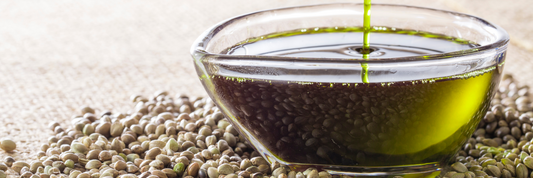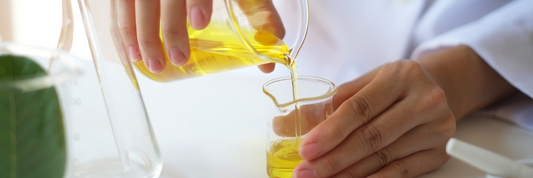
Is Your Skin Dry or Dehydrated?
What’s the difference between dry and dehydrated skin and should we be treating them the same?
It can be really tricky to differentiate between dehydrated and dry skin as they can often look and feel the same; dry, tight, flaky, itchy, and sensitive. But there is a big difference.
Dehydrated skin is a skin condition and lacks moisture (water).
Dry skin is a skin type and lacks oil (sebum).

Dry Skin
Naturally dry skin (alipoid skin) is a skin type which is genetically determined and characterised by the absence/lack of lipids due to smaller, underactive sebaceous glands.
Xerosis, on the other hand, is a common dry skin condition, defined as a pathologic dryness of the skin (xeroderma). Most people will encounter this at some stage in their life. Although xerosis can appear on any part of the body, it tends to affect the shins more than any other part.
Alipoid skin tends to look dull and exhibits no shine. Shine is indicative of sebum production so if you see any shiny areas on your face it’s unlikely you have alipoid skin.
Other causes of dry skin not due to genetics are diet and intrinsic (natural) aging.
If our diet is low in fat or fat-free and lacking in essential fatty acids it can impact on our skin causing it to become dry, itchy and flaky.
As we age we see a decline in sebaceous gland activity resulting in reduced sebum production and drier skin.
Dry skin can also be an issue for avid bathers. Frequent bathing in hot water, using harsh soap, strips lipids from the surface of the skin, just like detergent and hot water removes grease and oil from pots and pans when we wash up.
While frequent bathing strips lipids from the skin, dry skin due to aging is different. As we grow older we simply lose the ability to manufacture sufficient amounts of lipids to enable the barrier function to work properly, resulting in transepidermal water loss (TEWL).
I’m very fair with freckles and have naturally dry skin. Growing up, Like most youngsters, I really didn’t care much for my skin. It wasn’t until I hit my mid-thirties and realised my skin wasn’t looking quite as plump and fresh as my friends, that I started to formulate different products to keep it well-nourished and hydrated.
Appearance of Dry Skin
Naturally dry skin has the tendency to dehydrate, become thin, and show premature signs of aging a lot earlier than seen with intrinsic (natural) aging.
It has a dull rough surface and can sometimes become flaky. In severe cases the skin can become inflamed and cracked.
Improve Dry Skin
Although people with naturally dry skin are genetically predisposed to inadequate sebum production, like other skin conditions, there are several factors that can aggravate it.
Whether your dry skin is genetic, pathological or age related, here are a few things you can do to avoid aggravating it further. Try reducing the frequency of bathing. If possible, replace baths with a short shower using lukewarm rather than hot water. Try to avoid using harsh soaps and use a water miscible emollient or colloidal oatmeal instead.
After bathing, when your skin is still damp, apply an emollient (an emulsified body butter would be great) to improve skin barrier function and reduce transepidemal water loss (TEWL).
Dehydrated Skin
Unlike naturally dry skin, Dehydrated skin is very common.
Our modern lifestyles, diet, pollution, the weather, environment, and harsh cleansers can all contribute to skin dehydration. The weather and environmental factors; the sun, wind, air conditioning, and heating are a major cause of moisture loss and skin dehydration.
Dehydration can affect all skin types, even oily skin. Oily skin that is over cleansed and stripped of natural lipids, can lose water through trans-epidermal water loss (TEWL). Skin stripped of natural lipids will then produce more sebum to replenish what is lost. The skin may look and feel oily but will be lacking water and may become dehydrated.
Water is constantly being lost from our skin and in low humidity even completely normal skin can be subject to water loss.
Simply drinking plenty of water won’t be enough to rehydrate the skin. Minimising water loss, especially if the barrier repair function is impaired, is the key to skin hydration.
Appearance of Dehydrated Skin
Dehydrated skin has a very thin, crêpe like appearance that becomes more noticeable when manipulated. Dehydration at the deeper dermal layer can result in elastosis and sagging skin.
The good news; being a skin condition, means it can change at any time and we can take steps to improve it.
Improve Dehydrated Skin
The key to improving dehydrated skin is to minimise water loss. First we will need to help the skin attract and hold onto water and then prevent it from evaporating.
To do this we need to use products that contain both humectants (to increase moisture levels) and occlusive (to prevent TEWL).
If you are making your own skincare, try including some of the following humectants and occlusive in your formulations.
Humectants
Glycerine
Hyaluronic Acid
Sodium PCA (Sodium Pyroglutamic Acid)
Lactic acid
Amino acids
Hydrolised proteins
Occlusives
Squalane
Macadamia oil
Jojoba seed oil
Baobab oil
Shea butter
As you can see, although different, there is a definite correlation between dry and dehydrated skin.
When the barrier function is impaired skin is susceptible to TEWL resulting in dry and dehydrated skin which can lead to premature signs of aging.
In order to reduce TEWL and retain moisture levels within the skin we need to repair and/or maintain a healthy skin barrier function.
For skin to remain healthy we need to ensure it has a good balance of water and lipids.
Copyright, PureNature. This information is intended for personal use of PureNature customers and may not be reproduced, shared or used for commercial purposes without written consent.




















